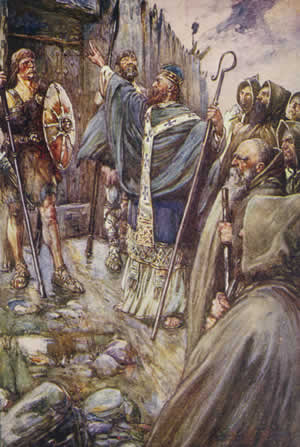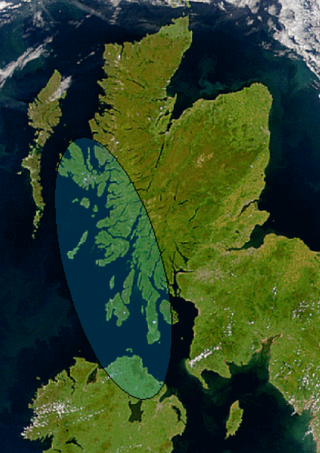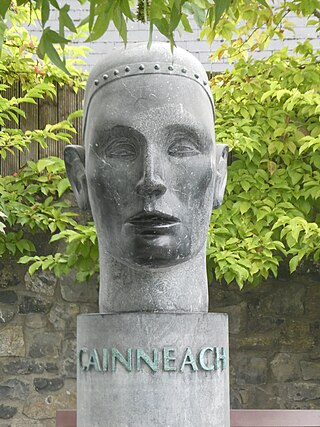Related Research Articles

Columba or Colmcille was an Irish abbot and missionary evangelist credited with spreading Christianity in what is today Scotland at the start of the Hiberno-Scottish mission. He founded the important abbey on Iona, which became a dominant religious and political institution in the region for centuries. He is the patron saint of Derry. He was highly regarded by both the Gaels of Dál Riata and the Picts, and is remembered today as a Catholic saint and one of the Twelve Apostles of Ireland.

Dál Riata or Dál Riada was a Gaelic kingdom that encompassed the western seaboard of Scotland and north-eastern Ireland, on each side of the North Channel. At its height in the 6th and 7th centuries, it covered what is now Argyll in Scotland and part of County Antrim in Northern Ireland. After a period of expansion, Dál Riata eventually became associated with the Gaelic Kingdom of Alba.

Áedán mac Gabráin, also written as Aedan, was a king of Dál Riata from c. 574 until c. 609 AD. The kingdom of Dál Riata was situated in modern Argyll and Bute, Scotland, and parts of County Antrim, Ireland. Genealogies record that Áedán was a son of Gabrán mac Domangairt.

Diarmait mac Cerbaill was King of Tara or High King of Ireland. According to traditions, he was the last High King to follow the pagan rituals of inauguration, the ban-feis or marriage to goddess of the land. The last High King to observe the ancient pagan Feis Temrach or Assembly of Tara which took place on Samhain every three years to pass or renew laws, approve annals and records.

The Annals of Ulster are annals of medieval Ireland. The entries span the years from 431 AD to 1540 AD. The entries up to 1489 AD were compiled in the late 15th century by the scribe Ruaidhrí Ó Luinín, under his patron Cathal Óg Mac Maghnusa, on the island of Senadh-Mic-Maghnusa, also known as Senad or Ballymacmanus Island, near Lisbellaw, on Lough Erne in the kingdom of Fir Manach (Fermanagh). Later entries were added by others.

Cainnech of Aghaboe (515/16–600), also known as Saint Canice in Ireland, Saint Kenneth in Scotland, Saint Kenny and in Latin Sanctus Canicus, was an Irish abbot, monastic founder, priest and missionary during the early medieval period. Cainnech is one of the Twelve Apostles of Ireland and preached Christianity across Ireland and to the Picts in Scotland. He wrote a commentary on the Gospels, which for centuries was known as the Glas-Choinnigh or Kenneth's Lock or the Chain of Cainnech.
Lasrén (also Laisrén, Laisrán) mac Feradaig or Lasrén of Iona (d. 605) was an Irish monk and the third abbot of Iona (c.600-605), in succession to Baíthéne. Lasrén worked during the abbacy of St Columba and administered the monastery of Durrow for the saint in the years before attaining Iona. Like Baíthéne before him, he was a kinsman of Columba from the royal dynasty of the Cenél Conaill. His father, Feradach meaning 'woodsman', was a cousin of the saint.
Adomnán or Adamnán of Iona, also known as Eunan, was an abbot of Iona Abbey (r. 679–704), hagiographer, statesman, canon jurist, and saint. He was the author of the Life of Columba, probably written between 697 and 700. This biography is by far the most important surviving work written in early-medieval Scotland, and is a vital source for our knowledge of the Picts, and an insight into the life of Iona and the early-medieval Gaelic monk.
Báetán mac Cairill was king of the Dál Fiatach, and high-king of Ulaid, from c. 572 until his death. He was the son of Cairell mac Muiredaig Muinderg and brother of Demmán mac Cairill, previous Kings of Ulaid. According to some sources, he was high-king of Ireland.
Domnall mac Áedo, also known as Domnall II, was an Irish king and son of Áed mac Ainmuirech and his consort Land, the daughter of Áed Guaire mac Amalgada of Airgíalla. Domnall was High King of Ireland from 628 until his death. He belonged to the Cenél Conaill kindred of the Northern Uí Néill.
Cú Chuimne was a monk and scholar of Iona. Cú Chuimne, along with Ruben of Dairinis, was responsible for the great compendium known as Collectio canonum Hibernensis, which is the first systematic western collection of canon law.

Saint Féchín or Féichín, also known as Mo-Ecca, was a 7th-century Irish saint, chiefly remembered as the founder of the monastery at Fore (Fobar), County Westmeath.
Dáibhí Iarla Ó Cróinín is an Irish historian and authority on Hiberno-Latin texts, noted for his significant mid-1980s discovery in a manuscript in Padua of the "lost" Irish 84-year Easter table. Ó Cróinín was Professor of History at NUI Galway and Member of the Royal Irish Academy. He specialises in the history of Ireland, Britain and Europe during the Middle Ages and Hiberno-Latin texts.
Events from the 6th century in Ireland.
Baithéne mac Brénaind was an Irish monk, one of Saint Columba's followers who accompanied him to Scotland around 563, and was the first successor of the abbacy of Iona. The Annals of Tigernach record his birth in 534, and his death was likely between 596 and 598 according also to the Annals of Ulster. Irish genealogical records indicate him to be the "son of Brendan, son of Fergus, son of Conall Gulban, son of Niall Noígiallach", thus being a member of the Cenél Conaill branch of the Northern Uí Néill, as the abbots of Iona following the death of Columba often were.
Ruadhri Ua Flaithbertaigh was King of Iar Connacht.
Beccán mac Luigdech was a 7th-century Irish composer of Christian poetry and monk of Iona. He is known for having composed two vernacular poems, Fo réir Choluimb and Tiugraind Beccáin, which were written c. 640 in praise of St Columba, the founder of Iona. Along with Amra Choluim Cille, the fragment of the Life of St Cumméne (Cummian) and Adomnán's Life of Columba, the poems offer a contemporary glimpse of the monastic familia of Iona in the 7th century. Beccán has been identified with the Beccán solitarius who along with Ségéne, abbot of Iona, was addressed in a letter written by Cumméne in c. 632–33 concerning the Easter controversy. He may also be the Beccán of Rùm, whose death is recorded in the entry for 677 in the Annals of Ulster.
Conchubhar Ua Flaithbertaigh, King of Iar Connacht, died 1186.
Coleraine Castle was a castle situated at Coleraine, County Londonderry, Northern Ireland.

St. Mochta's House is a medieval oratory and National Monument in County Louth, Ireland.
References
- Anderson, Alan O. & Majorie O. Anderson (eds.). Adomnan's Life of Columba. Edinburgh, 1961.
- Ó Crónín, Dáibhí. Early Medieval Ireland: 400-1200. Longman, 1995.
- Ó Crónín, Dáibhí. "Hiberno-Latin Literature to 1169". In Dáibhí Ó Crónín (ed.), A New History of Ireland vol 1: Prehistoric and Early Ireland, Oxford University Press, 2005.
- Mac Carthy, B., ed. (1895), Annala Uladh: Annals of Ulster (in Irish), English version at http://www.ucc.ie/celt/published/T100001A/index.html, Dublin
{{citation}}: External link in|others=